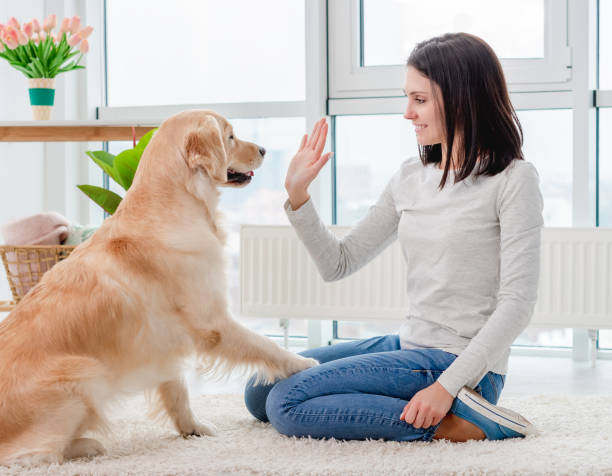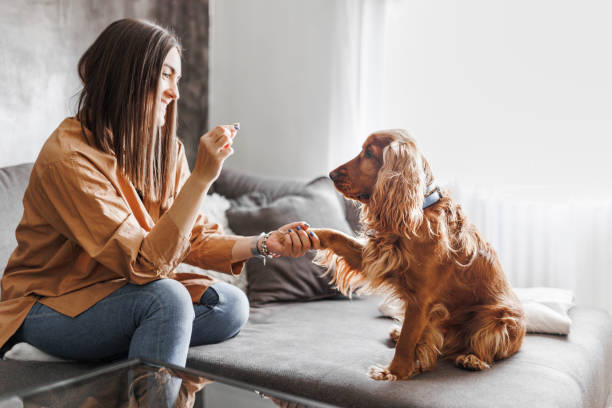Read How To Train Your Dog To Sleep In Their Bed. Having your dog pace around all night looking for a place to sleep could be more enjoyable. If your dog is unsure exactly where he should go each night, you can lose sleep attempting to coax him to settle down and unwind. The majority of family dogs form attachments with at least one family member. Your dog might wish to sleep next to you or with this particular member of the family. However, it doesn’t follow that the dog must sleep in your bed, only in your room. Possibly even in the corridor that leads to your bedroom.
Every night, he should sleep in the same location you put his bed. You can instruct him to go to bed when it’s time for bed and to know where his bed is. You and your dog should be able to enjoy a full night’s rest once he learns where his bed is and that he is expected to stay in it all night.
Creating Tasks

The key to teaching your dog to fall asleep in his bed is comfort and repetition. Finding the ideal bed for your dog’s requirements and placing it in the ideal location to allay any fears or separation issues he may experience are delicately balanced. Your dog may need a few weeks to learn to sleep on his bed; if that happens, you’ll probably need to move the bed to a new location. Many dog owners prefer not to sleep with their dogs in bed but don’t mind having a dog bed in their room. If your dog already has a bed in your bedroom, think about moving it closer to your bed so that when you are sleeping, your dog may look up and see you and hear your breathing. Knowing that you or at least another family member is close by will make him feel secure.
Getting Going
Make sure you understand how your dog sleeps before teaching him to use his bed. A little bed with raised edges that he may curl up into may be more comfortable for a small dog that usually sleeps in a tiny round ball. Consider requiring a larger bed if your larger dog spreads out once he falls asleep or lays on his back with his feet straight up in the air. Memory foam mattresses are excellent for supporting aching bones in older dogs. Make sure your dog has the right bed for their size, breed, and needs. To thank your dog for a well-done job, you should also have some additional treats on hand, potentially even in the sleeping area. Be patient with this and adaptable to change. If you’re upstairs on the other side of the house, your dog might not be pleased napping in the dining room.
The joy of cuddling with a pet is unmatched unless a large dog or cat sleeps on your head while you’re trying to sleep.
It can be beneficial for your pet to sleep on its bed if you have allergies or are interrupted. Sadly, it’s not as simple as purchasing a new pet bed. It will require some effort. But you can teach your pet to sleep on your bed if you’re consistent and patient. How? Read on.
How to get your dog used to sleeping on its bed
1.Select the ideal dog bed
You want the best for your dog, including the right size, shape, and needs-appropriate dog bed. Dog beds have several unique characteristics, including orthopaedic materials, cooling gel, memory foam, and water-resistant fabric.
When purchasing a dog bed, bear the following in mind:
Size of your dog: Dogs and dog beds come in all different shapes and sizes. Making sure your dog fits in their new bed is crucial in guaranteeing their comfort. The fabric (and how simple it is to clean): The bed should be cosy, but it also needs to be washable; removable coverings that can be washed in the machine get bonus points. Any particular requirements your dog has: Orthopedic materials, which certain beds are constructed of, are intended to soothe stiff joints. For dogs with thick coats, some companies offer cooling gel. The simple part is finding the ideal dog bed. It would be best if you now convinced them to sleep there. Consider including some of their favourite toys or a blanket to make it more inviting.
2. Determine their bedtime location
It would be best to decide where to put the dog bed after you have it. Make a note of your dog’s preferred sleeping spots. Each dog is unique. Therefore it’s possible they like to sleep next to you or in the living room while keeping an eye on the house. It’s typical to move the bed about at first to get the right position. Try not to shift their bed once you’ve located it, though.
3.Teach them fundamental rules
Using simple commands will take a little while to train your dog to sleep in its new bed. Keep them basic. Use verbal cues such as “go to bed,” “bed,” and “remain.” You should anticipate that this will take some time as they learn to connect the command with the desired behavior. Take them to their bed and issue the command to them first.
Remember to practice these instructions frequently, not only at night. It will assist your dog in learning and remembering what is expected if you practice them throughout the day.
4.Employ motivational techniques
Put treats. Food is a major source of motivation for many dogs. Treats are one of the most important ways to give positive reinforcement, albeit they are not the only ones. It’s as simple as rewarding them when they climb into bed, whether with a treat or a head pat. Another way to get their tails wagging and confidence up is to say “good boy” or “good girl.”
For dog owners, training their dogs to sleep in a dog bed can be crucial. After all, nothing is quite as unpleasant as being startled awake by a huge dog snoring in your face!
Our canine friends need a good night’s sleep to stay healthy and rested, just like their owners do. But even if you have the best dog bed at home, it can still be difficult if your dog prefers to nap on your bed or sofa.
Of course, there’s nothing inherently wrong with allowing a dog to sleep in your bed, but if you’re the kind of pet owner who wants to keep dogs off the couch and other pieces of furniture, you might need a little extra assistance in this area. After all, the more your dog gets used to sleeping there, the more difficult it will be to get them to leave!
While it could be difficult to convince them to leave the warmth and security of your bed, don’t worry. It is possible with practice, perseverance, and a lot of patience. Here are some helpful hints for teaching your dog to unwind in its ideal space, allowing everyone to get a nice night’s sleep.
Train in a space other than your bedroom.
It is advised to work in a different place other than your bedroom and not at night before you start exercising. Put the dog’s preferred bed or crate in a different area, such as the living room or guest room. This will prevent your dog from impulsively climbing onto your bed while gradually acclimating her to her new bed.
Purchase a plush dog bed.
To ensure your dog has the greatest possible sleep, you should invest in one of the best dog beds. Think about the bed’s dimensions, style, construction, and comfort level for your dog to spread out. The proper dog bed is crucial for your dog’s health and wellness because they sleep for 12 to 14 hours daily.
There are several options for pups and their sleeping postures, including memory foam beds and waterproof ones. Orthopedic dog beds are perfect for older dogs or those with joint issues. For greater comfort, it’s suggested to choose a large dog bed if your dog is on the larger side. One of the best dog crates can be appropriate for your dog if they like to explore the house late at night and disturb the family.
Include some well-known products.
You should provide a comfortable and familiar environment for your dog to withdraw. Make his bed more welcoming by placing their favorite blanket or favorite dog toys inside. Also, it’s a good idea to rub your hands over the dog bed to leave your fragrance.
Establish fundamental bed commands
Send them to bed with a predetermined “go to bed” instruction. This can be as straightforward as “go to bed,” “down,” or “bed,” but it must be utilized consistently throughout the procedure. Once your dog learns to associate the “go to bed” command with their new bed, they will eventually go to their bed on their own, regardless of where they are in the home. The next step is to instruct them to lie down and remain there by saying “down-stay.”
To get your dog used to searching for the bed, it is advised to practice this training in several locations throughout your house.Additionally, there is no harm in initially putting their bed next to yours, provided your bed is firmly off-limits. In this method, you can comfort them if they’re nervous by petting them and encouraging them. Your dog will eventually get used to having their bed!

Reward them for their good conduct.
When you first begin training, rewards and positive reinforcement are always terrific motivators. Once your dog enters the bed on their own or with your help, could you give them a yummy dog treat as a reward? Alternatively, you might give them the best dental chews, which are better for strong teeth and last longer. Encourage them more by expressing your love and affection for them. Just keep in mind that eventually, you should cease rewarding them with sweets because they will come to expect them every time they go to bed!
Split-up training sessions
It’s best to spread out your brief training sessions throughout the day rather than doing them all at once. Shorter sessions will be happier and less taxing for your dog, making it a more enjoyable experience. Remember that there is no set period for teaching your dog to sleep in its bed; it could take a few days to a few months. But with practice, positive reinforcement, and lots of love, they will soon be sleeping soundly in their bed!
How to make a dog go to sleep
When your dog has a cosy, supportive bed and follows a pattern, teaching them to fall asleep in their bed is simple. Make sure you’ve researched the best bed; our blog post on how to choose a dog bed has further information on this topic. Unfortunately, it won’t happen overnight, but teaching your dog to sleep in their bed will take some time, and doing so will be quite rewarding for both of you.
Before you start teaching your dog to sleep in their bed instead of yours, if they are accustomed to sharing it with you, think about where you want to put their bed. Hearing your breathing while you sleep will make your dog feel familiar and secure. You’ll need rewards and perseverance to educate your dog to sleep in their bed once you’ve purchased the proper size and shape bed.

